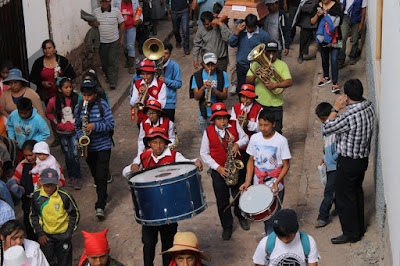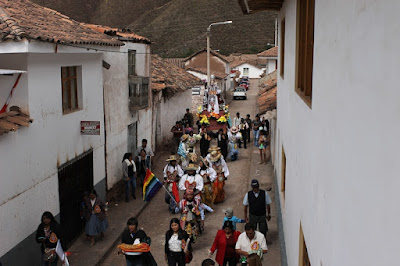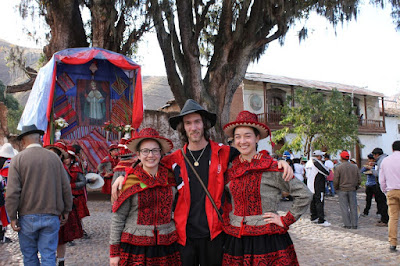Wow, ask and you shall receive. The internet speed picked after my last post. To celebrate, here's a post with plenty of visuals.
Part of the
beauty of a two year international volunteer program is witnessing
the yearly rhythm of a community more than once. The first time it's
all new; the second time it has a ring of familiarity. So this year
the feast of Saints Peter and Paul, June 29, was something to look
forward to.
For those of you
who don't remember all the details from
last year's post about SanPedro, San Pablo, basically
you need to know that Saint Peter is the patron saint of
Andahuaylillas, and his feast day is a major holiday.*
The parish decided to switch from dancing saqras (demons) and do a dance called cholo gorilaso. So the costumes weren't so colorful, and there weren't masks. I actually didn't dance with the parish this year because they didn't start
practicing until two days before, and I couldn't bail on my students
to go learn a dance. But I really enjoyed the day. I was able to take
in the day as a spectator. I got lots of video of dances and had more
time to play Foosball with students.
Here's a video showing some bits of the festival.
- A glimpse of the fireworks display on the plaza the night of the 28th. There's a similar fireworks show for the town's anniversary in December. Could you do this in the US? No. Is it a public saftey hazard? Absolutely. But is it cool? You bet.
- Mestiza Coyacha. "In the dance Qoyacha young people of both sexes participate. The men represent young Spainards and the women represent mestizas (mixed Spanish and indigenous origins). The Spanish men learn about mestizo customs dancing with the women, then the men invite the women to dance polka. It represents encounter between to cultures.
- Cholo Qorilazo. This is basically a cowboy dance. The men (the cholos qorilazos), dedicate all their work to care for the women and their horses. Cholo is a multilayered word that in this context means peasant worker (but in Lima is used as a racial slur). Qorilazo means "golden lassoo"
- Ccapacc Negro. This comparsa is sort of the host of San Pedro, San Pablo. They get the honor of carrying Saint Peter in the procession. Their dance is dedicated to black slaves. It is supposed to address the question "What if the slaves were free?" The black masks are a traditional part of the dance, and I can imagine this dance would play as well in the United States as it does in Peru.
- Merjeña. These are my students dancing! The 4th year class of FyA 44 always carries St. Ignatius in the procession and dances this dance. It mocks the hacnedados, the plantation owners. Thus the very long noses on the masks. The men stumble around getting drunker and drunk and the women dance with them. Usually the men have bottles of Cusqueña beer in their hands, but the high school students uses sodas instead. The most exciting part of the dance is when they shake the beers up and spray foam all over each other (and sometimes the spectators). The dance often ends with all the men "passing out" on the ground.
- Tinku. This dance, which originates in Puno, is based on an old tradition that goes by the same name. It's a ritualistic form of combat in which combatants swing at each other but don't actually make contact or cause physical harm. Unfortunately I was only able to film the start of their dance. It's a very high energy and fun dance to watch.
Follow the jump to see more pictures.
 |
| Saint Ignatius being carried by the 4th year students at FyA 44 (which is named San Ignacio de Loyola) |
 |
| The FyA 44 Band |
 |
| The parish comparsa (in red) processing |
 |
| St. Peter being born by the comparsa Ccapacc Negro |
 |
| Pd. Calilo and the parish dancers. |
 |
| You don't have to be a tourist to want a llama photo. |
 |
| FyA 44 4th year students dancing. |
 |
| The band wore Hawaian shirts. No one knows why. |
 |
| Take a bow. |
 |
| Parish staff (and some of their daughters) |
 |
| This is what JVs look like. |
No hay comentarios.:
Publicar un comentario